An interview with Christopher Hector
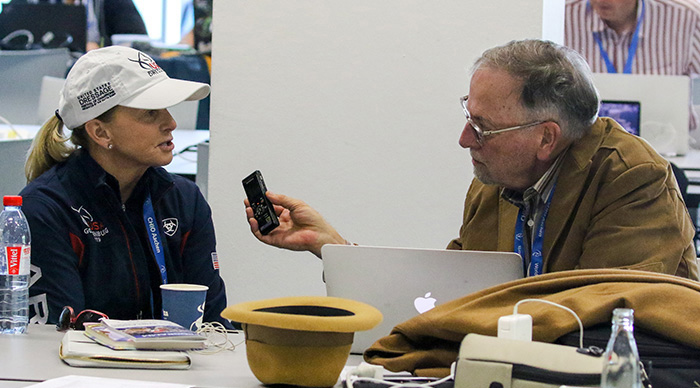
Photo – Kenneth Braddick dressage news
Debbie McDonald is a phenomenon. While there are have been some great dressage trainers in the past, none of them, have produced more really top Grand Prix riders than she has – and NONE of them has produced riders with more perfect style…
I was lucky enough to catch up with Debbie at Aachen…
It is amazing that all your riders have such perfect form… did you genetically select for that result, or can you make that result?
“I really can’t take credit for that. I am a perfectionist when it comes to my riders, and I will always give them input, but I honestly cannot say, I am the reason they ride that way.”
But they all ride in such a similar tactful, elegant way…
“That does draw attention to me for sure, as someone who wants our riders to represent their country, I think it is a beautiful way of riding and what everyone wants to see. For myself, in my career, being five feet tall, it was never a strength issue and I just try to pass those little things along, but as far as what the riders do, it’s all in their hands.”
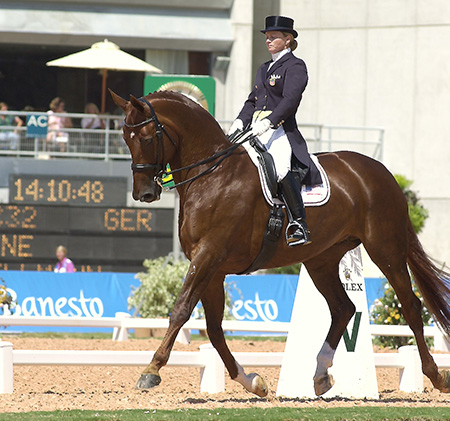
Debbie and her great mare, Brentina…
(Photo – Roslyn Neave)
Debbie, with the help of the American equestrian journalist, Nancy Jaffer, wrote a wonderful book, Riding Through, the book is out of print now, and the few brand new copies on the internet sell for up to $200, it is a pity because the work is packed with great advice – there are some second hand copies at a reasonable price, hunt for them.
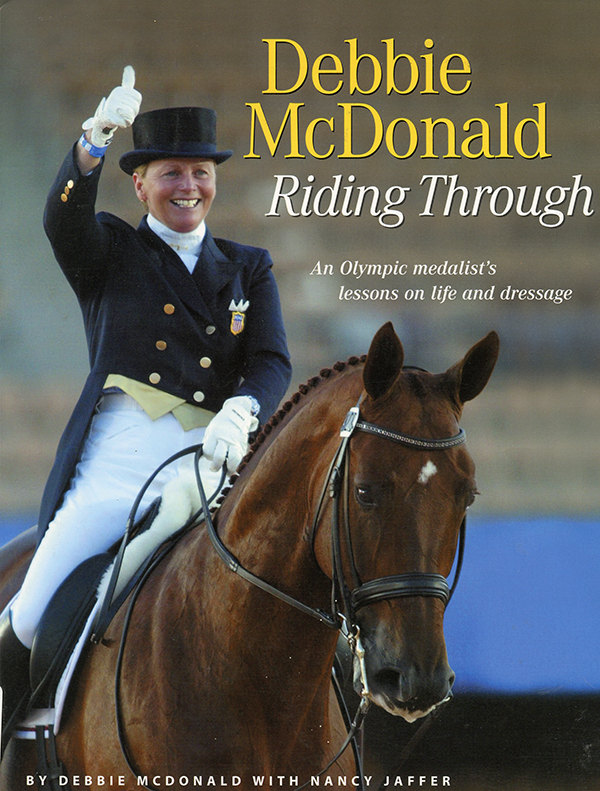
The chapter – Perfecting the Basics – starts with this little gem:
* develop sensitivity to the aids
* allow each horse to learn at his own pace
* keep the training simple enough so the horse always knows what you want
* there is no substitute for a good seat and independent aids.
You don’t have any particular exercises that you like your riders to practice?
“What we do have in place now is our physio man, Andy Thomas, and Andy and I work very closely together, because I am very picky – if I see the saddle is sitting to one side, we feel it is compromising the horse’s ability to get a better score because of the way the rider is sitting. In that regard we are doing more in that direction. I don’t know about other countries but it makes me crazy when riders, or the saddle, doesn’t sit in the middle.”
Again, from Debbie’s book another check box:
“Sit in the middle of the saddle after you’ve made sure your stirrups are even and let your shoulders and eyes follow the direction you’re going. Be careful not to sit off-balance. Think of riding a bicycle: when you turn the handlebars, you’re not turning your body the opposite way, or you can’t make the corner. You must ride with an even connection. If your reins are even and short enough, and your horse is correctly on the bit, it’s not hard to stay in the middle of the horse.”
Page 26, Riding Through
Adrienne Lyle told me that when she came to work and train with you, she first rode and showed your husband’s hunters – do you think that whole American hunter riding tradition, with its emphasis on style, lays a base for you riders?
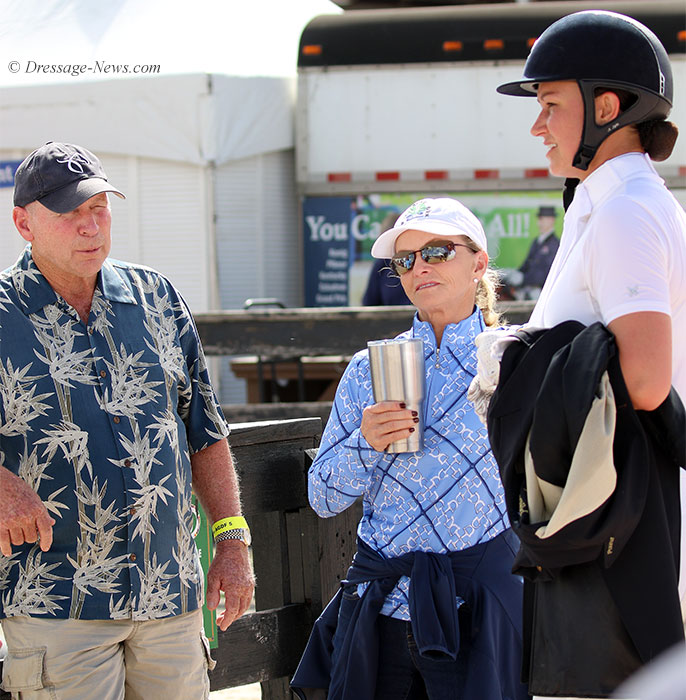
Adrienne Lyle with Debbie and her husband, Bob – he got Adrienne started!
Photo – Kenneth Braddick dressage news
“I would say that a rider who has had jumping in their background, that is not a disadvantage. That sort of riding takes a lot of finesse, technique, the striding, letter to letter or jump to jump and there is definitely a correlation there that can be put together with correct dressage riding. I think for sure in some ways it is beneficial, I think the riders who have had that background are the ones who are going to go for it, they are a little gutsier. I can’t say it was that that made Adrienne who she is, she rode as a kid on ponies and bareback and ran in fields. I mean she rode probably as long as she could walk and for me, that’s the most advantage someone could have, the fact that they have ridden everything since they were a very young age.”
more follows below
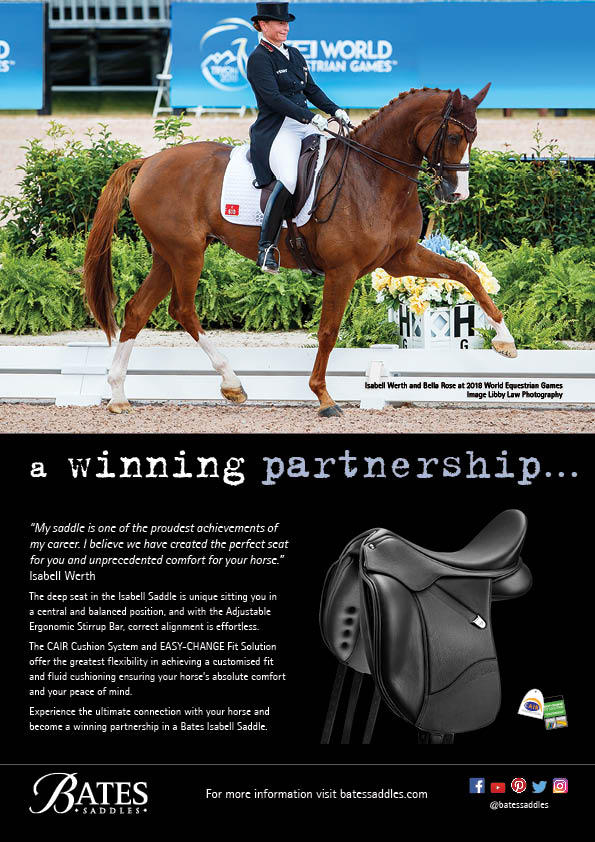
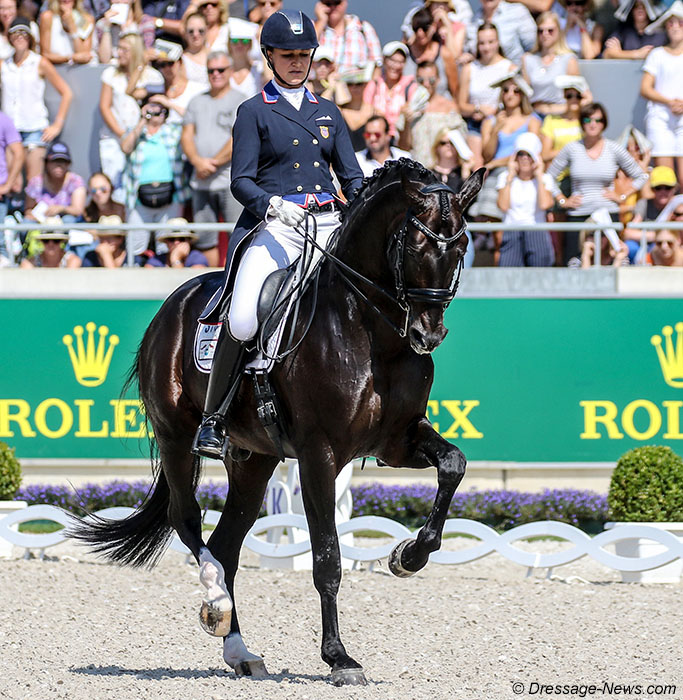
Adrienne and Silvano at Aachen
Photo – Kenneth Braddick dressage news
Check box:
If you have a horse who’s tough in the mouth and doesn’t want to halt, or has a tendency to throw his head up in the air at these moments, try flexing him to one side or the other as you ask for the halt, while ‘playing with the bit’ by gently moving your fingers to make the bit lively in his mouth for a moment. Just make sure you have a good connection (that is, you’re not doing it on a loose rein, and making sure you have a feel of both sides of the horse’s mouth, even when flexing slightly). Don’t take his head to strongly to either side. You’re not supposed to be wagging the head by pulling the bit through the mouth; this is a subtle movement. What you’re saying is, ‘Hey, pay attention.’ Playing the bit, also called shaking the bit, is a technique I use quite a lot, and one that can work for you.
Page 31, Riding Through
All around the world, countries are struggling to find four riders to make up a team, yet suddenly you have incredible depth at your top, it must be very hard to make your team now…
“I will say that the scores we are trying to achieve are higher than we’ve ever had before, that’s for sure. I think, like any country, I wish we had more depth. We have a lot of riders that are coming up, but they still have horses that are quite young, so, like in anything, there might be this gap year occasionally. As you know, horses are horses and if you maintain them well, and don’t drill them, then their longevity in the sport is greater.”
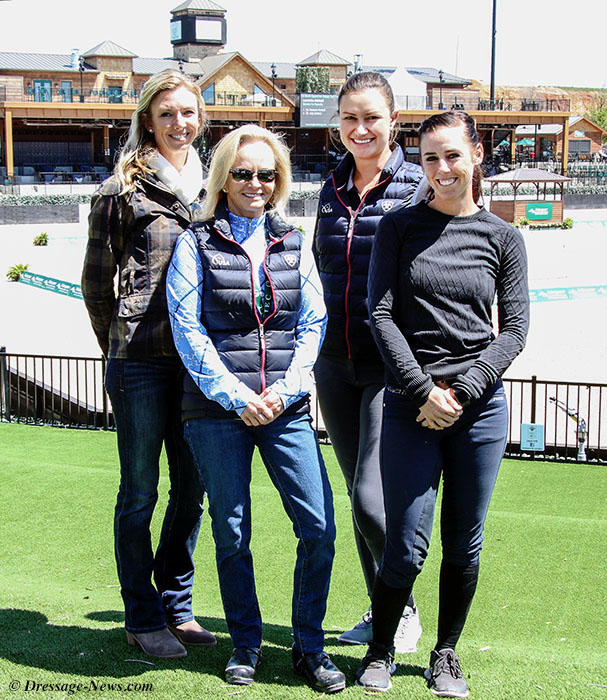
Debbie and three of her enormously talented squad: Laura Graves,
Adriene Lyle and Kasey Perry-Glass
Photo – Kenneth Braddick dressage news
Giving your horse confidence in you…
I spend as much time as I can with my horses when I’m in the barn. I call them all by their names. I give them lots of treats and scratch them or kiss them on the nose. If I’m home in Idaho on a day off, you’ll often see me at the barn clipping their legs or giving them a bath. I do all of that stuff. To me, that’s the whole package. I don’t think you can just get on a horse and expect him to perform for you if he has no love for you. Sure, for the most part they try to please, but will there be that extra little something in the relationship? I don’t think so. You have to put the effort in if you expect to get the effort out.
Page 39, Riding Through
Carl Hester says his horses go out hacking at least once a week, do you have a similar regime?
“Yes, a lot of our horses are now doing the water treadmill to get that extra fitness edge, no stress on the legs but it can actually achieve the fitness level and work the muscles in there. Definitely we have at least one, if not two, days a week where they go out in the jump ring, or, around Wellington, you can ride around the roads, it’s designed for horses. I would say that I myself, and I think also my riders, are strong believers that the horses need to get out of that rectangle and go and be a horse, just look at the world. Let noise be around them, we make their world so quiet, then when you come into a big stadium like Aachen, they go holey moley! What’s this about? We try to do what we can.”
Quality of the Gaits
Flashy movement does not equal quality of the gaits, so don’t push for it if everything else is not in place. It comes with time from a horse thoroughly enjoying his work, who is relaxed and supple – that is, showing freedom of movement – in the connection. Expression, or if you want to use a trendy term, ‘bling’ can be manufactured to some extent, but a 5-foot woman isn’t going to be able to produce it if the horse isn’t willing to give it. Expression only comes from a horse proud and happy in his work, and it can show itself in different ways. Keep monitoring the quality of the gait as you work. If it becomes jeopardized in a lateral movement, get out of it for a moment, get the quality back while moving straight ahead and then re-address the lateral movement. Once you train a horse to do a lateral movement incorrectly, it’s 10 times harder to fix the problem than doing it correctly from the beginning.
Page 47, Riding Through
Do you think it is essential to come over to Europe and for your riders to compete here, to finish them off?
“Yes, I do. I think it’s very important. Not only do we need to be compared head-to-head we need European competition, otherwise you just stay in your own little country and you don’t really know where you stack up in the real world. It’s very necessary to come over here, and the score is not so important, whether you end up doing well, or maybe that wasn’t your best show, you still come out the other end so much better educated, and so much more knowing what it takes.”
Debbie and Brentina competing at Aachen – in the Kür
Is it a fine call on your part – knowing when they are ready to come to Europe and have a learning experience and when it is too early and they are going to fry their brains?
“There’s always a bit of tweaking in everything we do. I think all dressage riders are perfectionists. There is always something that can be a little better than it is. We have one horse here that I think it might be a little premature for him to be going into that huge stadium, it’s a young one that Adrienne is riding. And you know what? It’s like she said, we won’t know until he goes in how he’s going to handle the crowds. There are times when you’ve just got to put them out there. Gods knows, I’ve watched some of the top riders in Europe here when their horses have spun around and really freaked out, but they don’t quit, the horses just have to get used to going into the environment, and that is harder for us in the States, it is hard for us to find those environments where we can get a stadium full of people.”
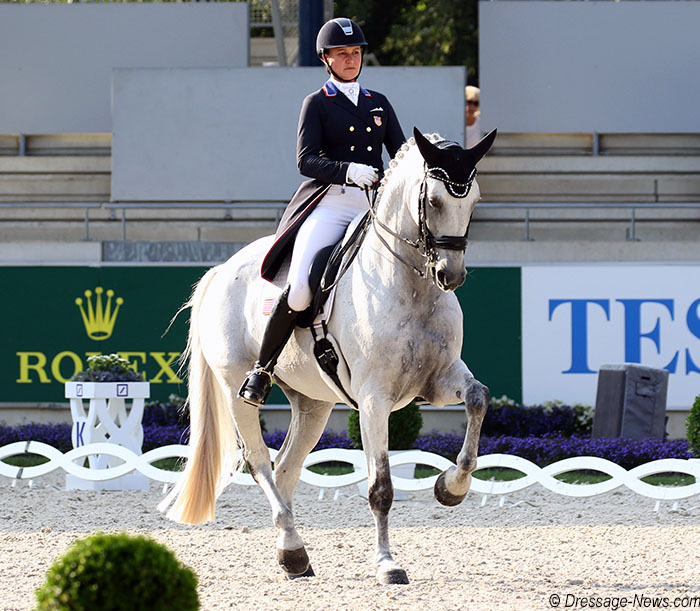
The young one – Harmony’s Duval at Aachen… Would he cope? Yes!
Photo – Kenneth Braddick dressage news
Coping with the Judging
Here’s my feeling: I’m not doing the sport because I feel like I want to win or should win; I just love the surge of adrenaline, the harmony and the partnership I have with my horses. For me, it’s kind of a test to see where I am in my training with my horses and where I can improve it.
Sometimes, when you’re not pressured by showing situations, you let parts of your training slide. So showing is important to me for that reason, among others.
I truly love the sport, but I can’t say I haven’t been extremely disappointed at times. At one point, I even thought about quitting. It would however, have been difficult because my sponsors very much want to enjoy watching their horses compete, and they love traveling and doing the things that go along with that. I can’t take that away from them. And when you come down to it, competition has done a lot for me.
…If you are only in it for the ribbon, you’re putting out a lot of effort for the wrong reasons. You have to appreciate what you’re getting from showing and make it part of a learning experience. Take the positive and try not to dwell on the negative. Don’t whine and be a bad sport. Not everyone is going to remember who won the gold medal in whatever competition in whatever year, but if you have a good performance, that is something people will carry with them forever – and you will too.
Page 85, Riding Through
It’s very expensive to take horses to Europe to compete, are you getting a lot of support from your Federation or is it individual owners like Betsy Juliano, who are making this happen?
“It’s both. The Federation does what it can, but it’s not fully funded, unless you are on an Olympic team or something like that. For a trip like this one to Aachen, it’s not fully funded – they get so much money, then they have to find the rest.”
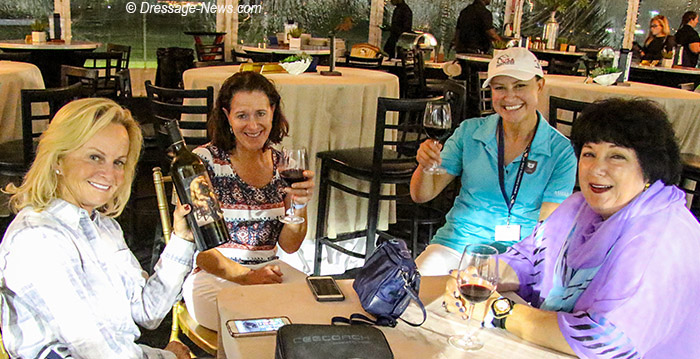
Traveling as a team: Debbie, Jennifer Baumert who rode Handsome for team silver and individual bronze at the 2019 Pan American Games , Adrienne Lyle and Betsy Juliano – Betsy owns both Handsome and Silvano.
Photo – Kenneth Braddick dressage news
But you are very lucky that you have a tradition of wonderful owners who love the sport like Perry Thomas…
“Absolutely, and I would love to see more of those owners. Let’s be honest, even over here where the prize money is good, even if you are doing well, it is not a money maker for the owners, it’s a passion, a journey they love to go on with their riders and their horses. I just love to see those people come into the sport because they really are in it for the love of the sport.”
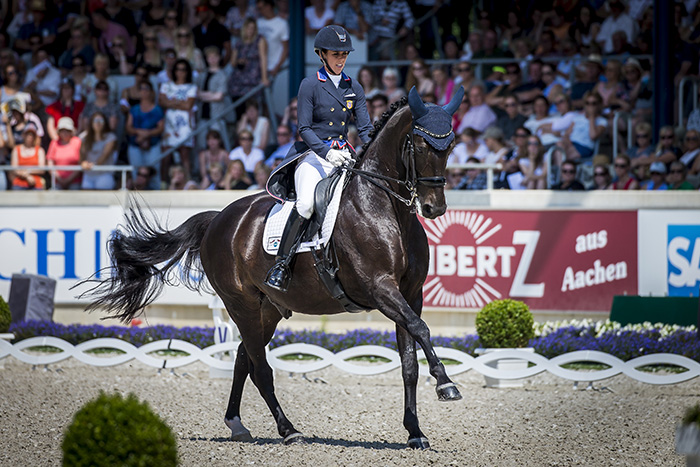
Kasey Perry-Glass and Dublet
Photo – Rebecca Ashton
Question: How will I know when I’m riding my horse through? Is there any test I can do to tell?
Answer:If you can move from a straight line in the trot or canter into a shoulder-in and take it into haunches-in and back to shoulder-in, and the horse stays in the same frame and rhythm, he’s totally connected. Then you’re riding through.
Page 125, Riding Through
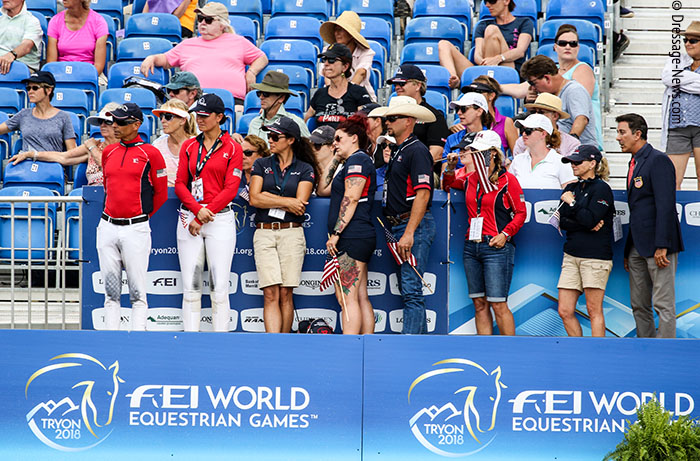
Has your rôle changed much since Robert really retired?
“I miss him standing next to me. We worked very well together, but my coaching rôle has not really changed. Little changes, I do the chefs meetings now and thank god for the staff at USEF, because they do a lot of work for us, it is not like we are sitting on our computers doing a ton of work. I will say there are more emails, but for the most part, no, it hasn’t changed that much.”
You were at Göteborg for the World Cup final – right now do you think dressage is in a good place?
“I believe so, but there will always be a few people who think that we are not doing our best for the horses, and that’s very sad for me because I think if some of those people could spend time back at the barns, and see how much these riders invest themselves in their horses – the riders would give up anything in their lives to make sure their horses were well cared for. It saddens me when I see people putting pictures out there that are a moment in time, and then trying to slander dressage. It’s very sad for me that we are in a time like that, because these horses are very loved and are very well taken care of.”
Here at Aachen this year, there were special information stewards on hand during the training session in case any of the spectators wanted to raise issues. Sure some people ride better than others, but I didn’t see anything objectionable, there weren’t any horses with their heads hauled into their chests, that era has gone…
“I believe it has. When I go to shows now I never watch the warm up arena and think, this isn’t the right thing. Everybody has put themselves in a better place.”
I was sitting there this morning with George Morris, watching the training and we were hit by how much better the horses are…
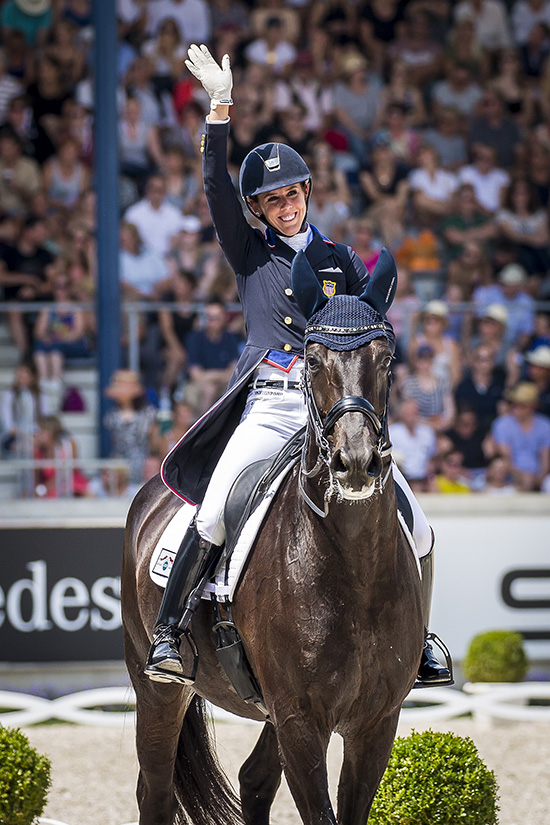
Kasey and Dublet – such wonderful horses! Photo – Rebecca Ashton
“It’s also what we’ve learnt about the horses and how to manage them, and increase their longevity in the sport by doing things to help them. Physios, massages, there’s so much that can be done. And being very mindful of not over-working them… there’s lots of things that go into it.”
But we are also starting with much better clay…
“There’s no doubt of that, it’s a changed sport in that regard of it. The horses that are out there now at the top are definitely a breed that everybody wants, a look everybody wants – and they are not easy to find.”
Question: How do I keep my horse’s attention, someone comes out of the barn or an engine nearby starts up, and he gets so distracted he doesn’t even know I’m on his back? What do you do if this happens at a show?
ANSWER:The answer to this question starts at home. This is all about what we call submission, If you have a horse who acts this way, you need to make sure you have his full attention. When something happens that gets the horse startled, you should address it by doing transitions. Bring the horse back, then leg-yield or circle, whichever will give you the most control for the moment. Whatever you do, don’t run the horse forward; that only gives him the advantage in this situation.
Insist that the horse listens to the half-halt. It might be that he gets so fired up that you are afraid to bring him all the way to the walk for fear he will buck you off. If the horse is ready to uncork, keep moving. Try another leg-yield, or, if you and your horse are more advanced, haunches-out or haunches-in. You really have to experiment to see what gives you the best results. Once you’ve gotten his attention, continue with your work, Try to set this situation up again so you can perfect your solutions before going into the show ring. Even though you will not be able to use these techniques in the arena, if the horse learns to pay attention to you time after time, it will become second nature and you will be able to control him in training.
Page 126, Riding Through
more follows below
Of course the only exception to the rule that all today’s top horses are brilliantly dressage bred, both in terms of breeding and ‘look’ is your number one horse, Verdades…
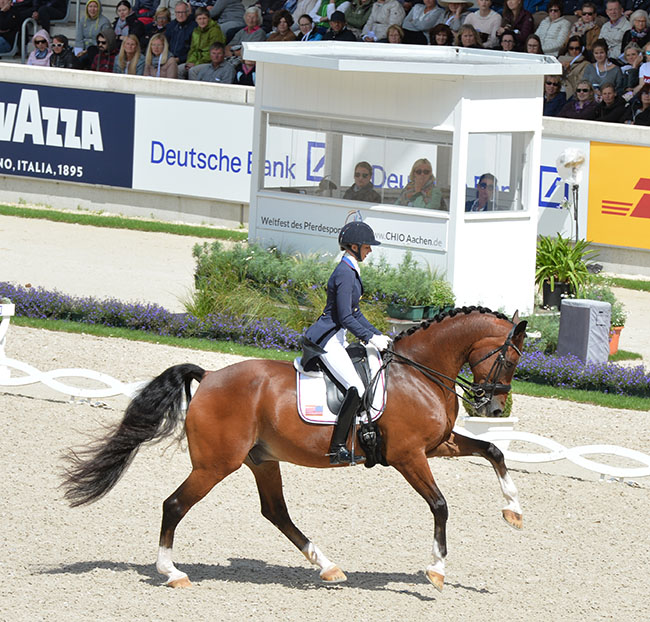
“Absolutely.”
All those rules are there to be broken…
“They are. You have to give people a dream. Don’t ever give up on a dream because you think, I’m never going to have that special horse because I can’t go out and spend a lot of money. There are a lot of stories out there that people don’t know about – that these people bought a horse for not a lot of money and it turns out to be one of the best horses in the world.”
If someone came along to you and said, I’ve got this horse and I want it to be a dressage star, and its mother is by an English Hackney and behind that four generations of Dutch harness horses, you would have said, mmm…
Debbie is laughing, laughter is never far away when you are talking with her.
“But do you know what, as long as I have been in the dressage and the jumping world, breeding is breeding yes, but they are all individuals and I never look, is it a Hanoverian? Is it a Dutch Warmblood? I don’t look at that at all, you look for what you want in a horse. That is always individual, and that’s why most horses have homes.”
What is your run into the Tokyo Games going to look like – when they happen? Are you going to do another European tour leading up to that?
“We believe so. We are still in the strategic planning stage, starting from Tokyo and working backwards, looking at what’s going to be best for the horses, and the time periods where they can have breaks, but still be able to stay in top form for the Games.”
You should train them in Wellington in the middle of summer if you want to replicate what you are going to find in Tokyo at that time of the year…
“That is absolutely a very strong probability. It’s going to be hot and humid. I think preparing in the States helped us at the WEG. The European horses weren’t used to going in that heat and humidity. I think in the end, our horses came out better because they trained in weather like that.”
Is every day another buzz for you, does the passion still burn?
“You just never know what the next day is going to bring…!”
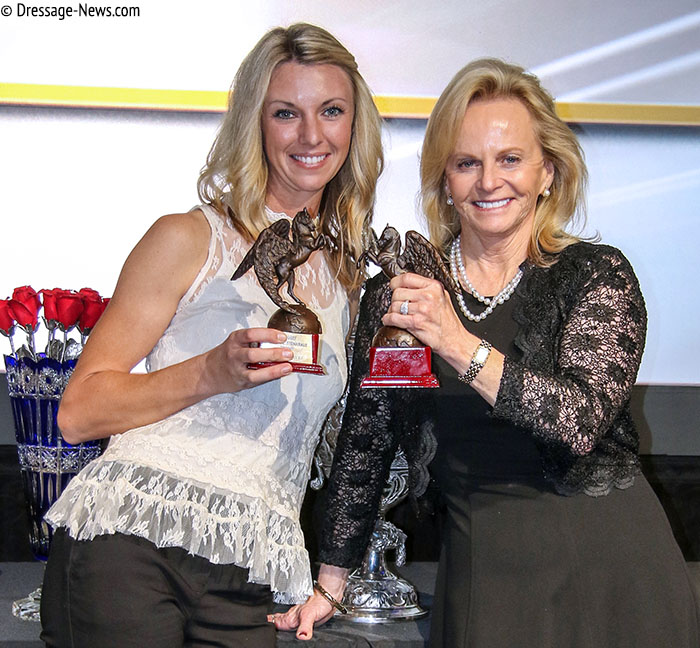
Laura and Debbie
Photo – Kenneth Braddick dressage news
POSTSCRIPT
Debbie and her husband Bob, have been through a terrible time in the last few months, with ‘SafeSport’ banning Bob for life, only to later clear him of any wrongdoing. Now Debbie can get back to what she does best, guiding American dressage in a beautiful and effective direction.
Want to breed your own dressage star? Check out Total Hope
at International Horse Breeders! There’s a great selection so think about what stallion to choose now for the 2023 season in Australia
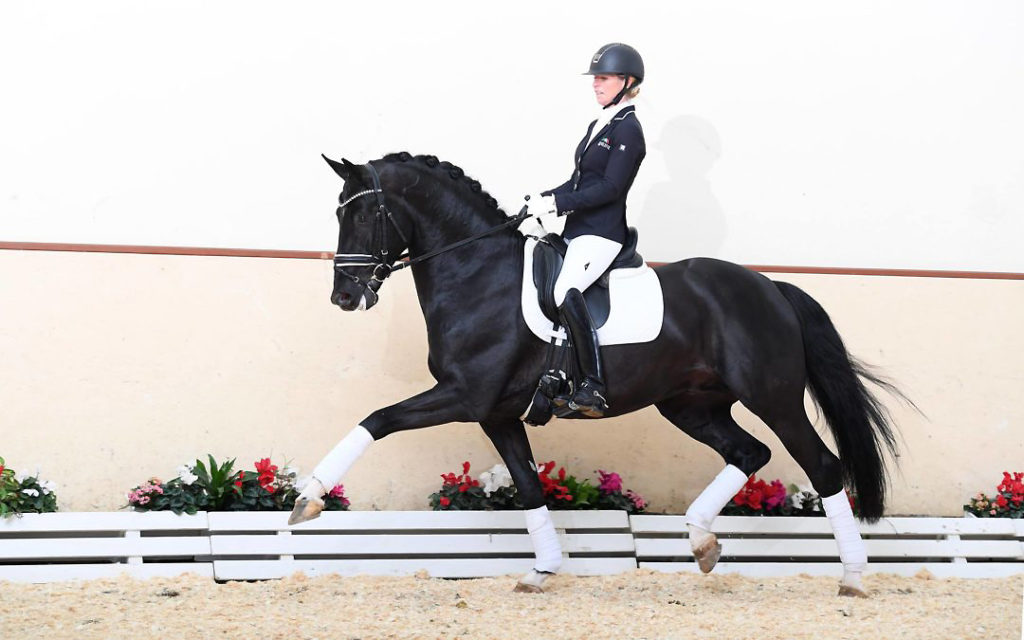

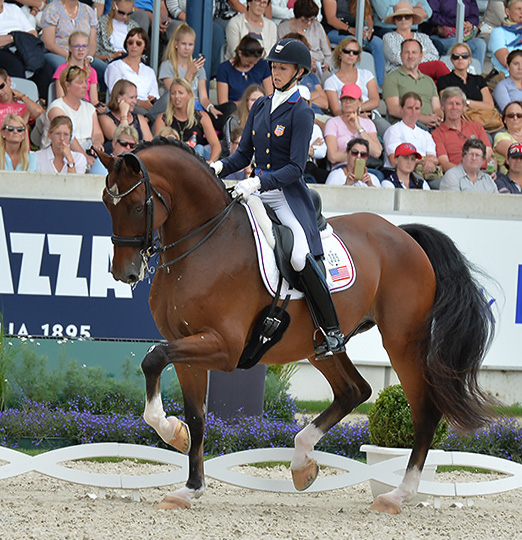
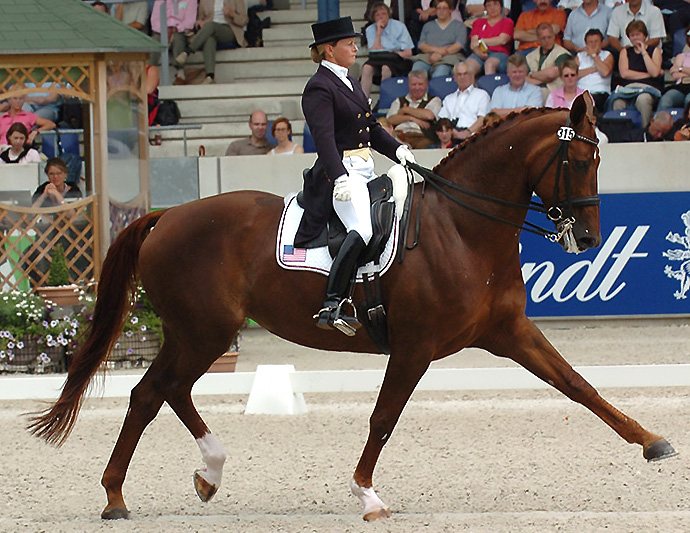
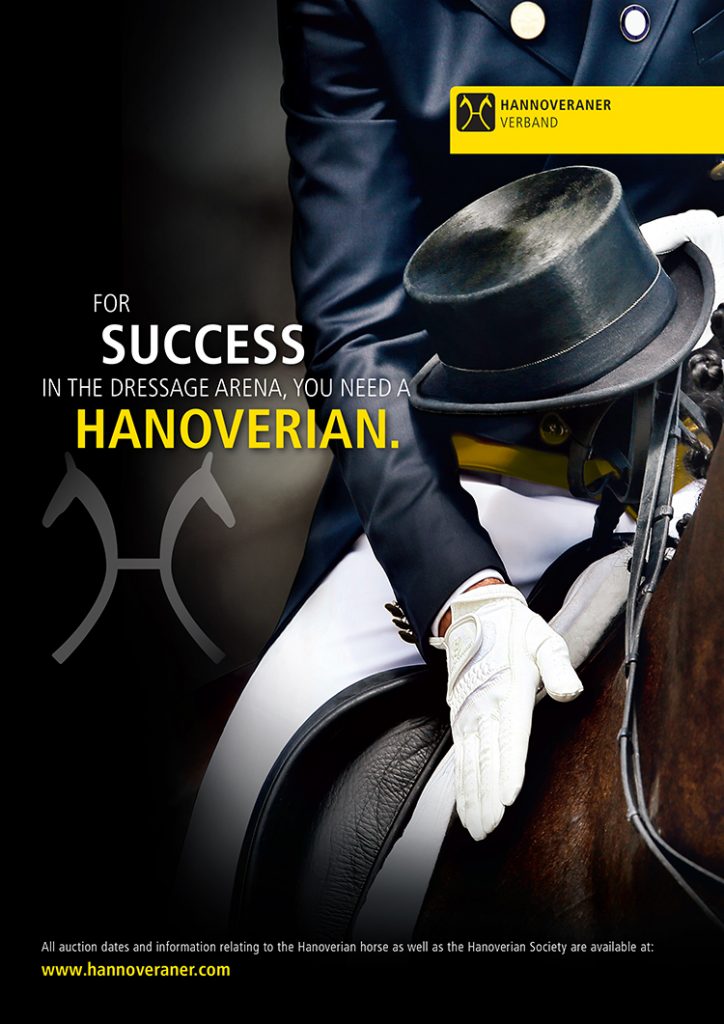
Great read and some great quotes from her book.
She’s a national treasure